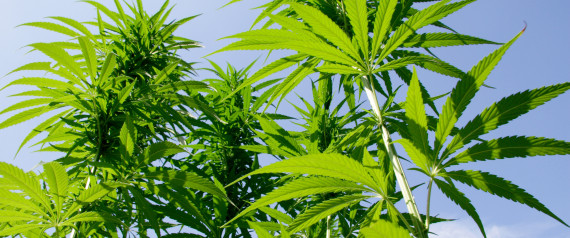
Nope. It's because U.S. policy is finally acknowledging that hemp can help restore our agricultural economy, play a key role in dealing with climate change and, best of all, allow American family farmers to get in on a hemp market that, just north of us in Canada, is verging on $1 billion a year.
Hemp is a variety of cannabis -- and thus a cousin of marijuana -- that contains 0.3% or less of the psychoactive component THC. (Marijuana plants typically contain 5% to 20% THC.) You can't get high from hemp, but starting in 1937, U.S. drug laws made cultivating it off-limits.
Finally, the U.S. hemp industry is back. A provision in the 2014 farm bill signed by President Obama on Feb. 7 removed hemp grown for research purposes from the Controlled Substances Act, the main federal drug law.
Not a moment too soon. American farmers have been watching as Canadian farmers clear huge profits from hemp: $250 per acre in 2013. By comparison, South Dakota State University predicts that soy, a major crop, will net U.S. farmers $71 per acre in 2014.
Canada's windfall has been largely due to the American demand for omega-balanced hempseed oil. But hemp is also a go-to material for dozens of applications all over the world. In a Dutch factory recently, I held the stronger-than-steel hemp fiber that's used in Mercedes door panels, and Britain's Marks and Spencer department store chain used hemp fiber insulation in a new flagship outlet. "Hempcrete" outperforms fiberglass insulation.
Farmers I've interviewed from Oregon to Ohio have gotten the memo. In a Kansas-abutting corner of eastern Colorado, in the town of Springfield, 41-year-old Ryan Loflin wants to save his family farm with hemp. "It takes half the water that wheat does," Loflin told me, scooping up a handful of drought-scarred soil so parched it evoked the Sahara, "and provides four times the income. Hemp is going to revive farming families in the climate-change era."
From an agronomic perspective, American farmers need to start by importing dozens of hemp varieties (known as cultivars) from seed stock worldwide. This is vital because our own hemp seed stock, once the envy of the world, was lost to prohibition. This requires diversity and quantity because North Dakota's soil and climate are different from Kentucky's, which are different from California's. Also, the broad variety of hemp applications requires distinct cultivars.
Legally, farmers and researchers doing pilot programs in the 15 states that have their own hemp legislation (including California) now have the right to import those seeds. The point of the research authorization in the farm bill is explicitly to rebuild our seed stock. Such research is how the modern Canadian hemp industry was kick-started in 1998.
But one final hurdle has been placed in front of American hemp entrepreneurs. In Kentucky, U.S. Customs officials, at the behest of the Drug Enforcement Administration, in May seized a 286-pound shipment of Italian hemp seed bound for the state's agriculture department. After a weeklong standoff, a federal agency had to be reminded by the federal courts that the law had changed and Kentucky's seed imports were legal.
The problem is as much an entrenched bureaucratic mind-set as the ink drying on the new federal hemp policy. DEA Administrator Michele Leonhart told a law enforcement group last month that the hoisting of a hemp flag above the U.S. Capitol last July 4 was "the low point in my career."
It should have been a high point. Hemp's economic potential is too big to ignore. When he was China's president, Hu Jintao visited that nation's hemp fiber processors in 2009 to demand that farmers cultivate 2 million acres to replace pesticide-heavy cotton. Canada funded its cultivar research for farmers, with today's huge payoff.
Even Roger Ford, a politically conservative Kentucky utility owner, told me his Patriot BioEnergy's biofuels division would be planting hemp on coal- and tobacco-damaged soil the moment it was legal. Why? To use the fiber harvest for clean biomass energy. "We have a proud history of hemp in the South," Ford told me.
Congress knows the farm bill hemp provision is just a baby step. The real solution is the Industrial Hemp Farming Act, introduced by Sen. Ron Wyden (D-Ore.), which would allow nationwide commercial hemp cultivation. Colorado, already ahead of federal law on legalizing psychoactive cannabis, is also in front on hemp; it has a state law allowing commercial hemp cultivation. At least 1,600 acres were planted this season.
Wyden's bill should be fast-tracked. In the meantime, Rep. Thomas Massie (r-Ky.) believes hemp is so important for the Bluegrass State that he's not waiting for another brouhaha over seed imports. He added an amendment to a bill that controls the DEA's budget to specifically protect imported hemp seeds from seizure. It passed in the House 246 to 162 on May 30.
It's a necessary move: Just last week at the Canadian border, the DEA seized another shipment of hemp seeds, this time bound for Colorado farmers. This counterproductive nonsense must stop.
American farmers and investors need our support to catch up with Canada's and the rest of the world's hemp head start. Now. As Loflin put it when I toured his family's 1,200-acre Colorado spread, "I'm planting hemp to show my neighbors that small farmers have a real option as businesspeople in the digital age."
We're down to 1% of Americans farming; it was 30% when our world-leading hemp industry was stymied in 1937. The crop is more valuable today than it was then. We should be waving flags and holding parades for the farmers ready to plant the crop that Thomas Jefferson called "vastly desirable." I know I'm ready. To cheer, and to plant.

No comments:
Post a Comment